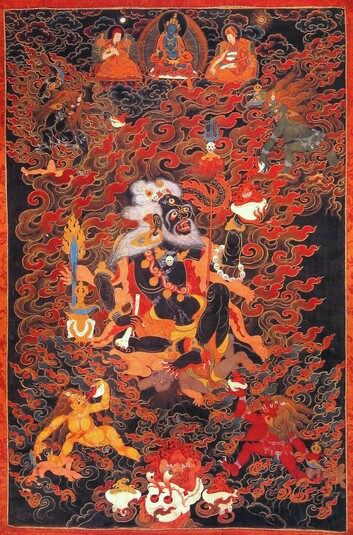
Item: Mahakala (Buddhist Protector) - Brahmarupa (Brahmin Form)
| Origin Location | Tibet |
|---|---|
| Date Range | 1700 - 1799 |
| Lineages | Sakya, Ngor (Sakya) and Buddhist |
| Material | Ground Mineral Pigment on Cotton |
| Collection | Asian Art Museum of San Francisco |
Classification: Deity
Appearance: Mahasiddha
Gender: Male
Brahmarupa Mahakala (Tibetan: gon po dram ze. English: the Mahakala who appears in the form of a Brahman).
Sanskrit: Brahmarupa Tibetan: Dram ze
Tibetan: Dram ze
Appearing as an Indian Brahman, dark brown in colour, he has one face and two hands. With the right hand he holds a human shin-bone trumpet and in the left, upraised, a human skull filled with blood. The hair, beard and eyebrows are white. Wearing bone ornaments, intestines and a human skin he sits atop a human body. At the edges of the pristine awareness wisdom fire are four dakinis, ghoulish in appearance, dynamic in posture, Dombini, Chandali, Rakshasi and Singhali Devi - black, red, yellow and green. They are naked with disheveled orange hair, each holding a curved knife and a skullcup.
Directly above, floating on the clouds, is Vajradhara, blue in colour. Seated to the proper right side of the central figure is Ngorchen Kunga Zangpo (1382-1456 [P1132]) and on the proper left wearing a white lower robe is an unidentified Sakya Lama of the Khon family.
The back of the painting has an inscription giving the name of Kunga Gyatso (birth 17th century [P4461]) as the donor, which quite possibly is the teacher of Zhuchen Tsultrim Rinchen (1697-1774 [P801]). The painting was offered to Ngor Ewam monastery, founded in 1430 by Ngorchen Kunga Zangpo.
ཨེ་ཝཾ་ཟིལ་ནོན་ཁང་ཆེན་ལ། དགེ་རྒན་ཀུན་དགའ་རྒྱ་མཚོ་ཡི། ལྷག་བསམ་དཔལ་མགོན་ཞལ་ཐང་འདི། ཕུལ་བས་བསྟན་དང་རྣལ་འབྱོར་ལ། སྡང་བའི་དགྲ་དང་གནོད་སེམསཅན། མྱུར་དུ་རྣམ་ཤེས་ཆོས་དབྱིངས་དྲང་།
"At the majestic Ewam monastic center, the teacher Kunga Gyatso offered this Shri Natha painting with pure intention in order to protect the teachings of the Buddha, and we the yogis, from harmful enemies and demons, and lead quickly to realize the dharmadhatu."
Short History: When the great Tibetan Translator Nyen Lotsawa received the Manjuvajra Guhyasamaja (also known as the Jnanapada Lineage) empowerment from the dakini Risula, she also bestowed the initiation of the Mahakala (Chaturmukha) in the special form according to the Guhyasamaja Tantra. At this time she gave him as a servant a dark skinned Brahman. When Nyen Lotsawa and the Brahman reached Nepal the servant changed appearance and took on the form of a monk, an appearance more conducive for travelling in Tibet. After the passing of Nyen Lotsawa the monk remained with Lama Nam Ka'upa and then later with Sachen Kunga Nyingpo.
Brahmarupa Mahakala is none other than Chaturmukha Mahakala of the Guhyasamaja Tantra. In his wrathful appearance he is black in colour with four faces and four hands, surrounded by the four dakinis. In the Sakya School it is inappropriate to show the wrathful form to anyone who has not received the initiation. For this reason the iconographic tradition arose for painting Chaturmukha in the form of the Brahman servant of Nyen Lotsawa. At the bottom of many Sakya 'tangkas' it is a common theme to see Panjarnata Mahakala flanked by the Brahman on the right and Shri Devi (Palden Lhamo) on the left - the three main protectors of the Sakya School.
Indian Lineage: Vajradhara, Nagarjuna, Balimtapa, Buddhajnana, Marmedze Zangpo, Shrideva, Drime Bepa, Ratnavajra, Ratnakirti, Risula Dakini, Nyen Lotsawa, Lama Nam Kaupa, Sachen Kunga Nyingpo, etc. Jeff Watt 8-2005
Collection of Asian Art Museum of San Francisco
Collection of Asian Art Museum of San Francisco (Masterworks)
Collection of Asian Art Museum of San Francisco (Sakya Selection Masterworks)
Buddhist Deity: Brahmanarupa (Masterworks)
Mahakala: Brahmanarupa Page
Buddhist Protector: Mahakala Art History
Mahakala, Brahmarupa (Sakya)

